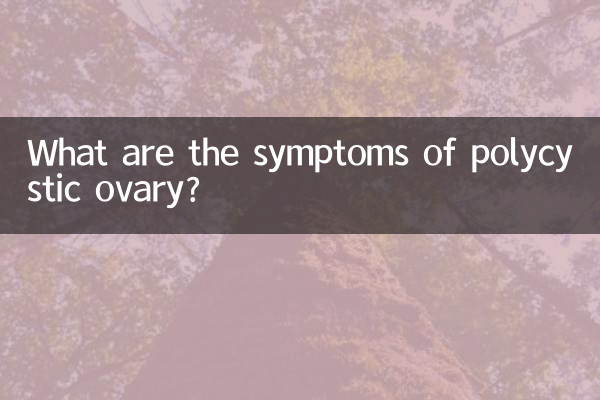What are the symptoms of polycystic ovary?
Polycystic ovary syndrome (PCOS) is a common endocrine and metabolic disease in women of childbearing age and has become a hot topic in the health field in recent years. This article will combine recent hot discussions on the Internet to introduce in detail the typical symptoms of polycystic ovary syndrome to help female friends better identify and deal with this problem.
1. Recent network-related hot data

| Hot search platform | Related topics | Search volume (last 10 days) |
|---|---|---|
| #Polycystic ovary weight loss# | 258,000 | |
| Douyin | "Polycystic Diet Conditioning" | 183,000 |
| little red book | Polycystic ovary self-rescue program | 126,000 |
| Zhihu | Can you get pregnant naturally with polycystic cysts? | 97,000 |
2. Main symptoms of polycystic ovary syndrome
The symptoms of polycystic ovary syndrome vary from person to person, but typically include the following typical symptoms:
| Symptom type | Specific performance | incidence |
|---|---|---|
| Abnormal menstruation | Oligomenorrhea, amenorrhea, irregular bleeding | 70%-80% |
| Hyperandrogen manifestations | Hirsutism, acne, hair loss, excessive oil secretion | 60%-70% |
| Ovulation disorder | Infertility or difficulty conceiving | 50%-60% |
| Metabolic abnormalities | Obesity (especially waist and abdomen), insulin resistance | 40%-60% |
| skin changes | Acanthosis nigricans (dark skin on neck/underarms) | 30%-40% |
3. Detailed description of symptoms
1.Menstrual disorders
This is the most common and most overlooked symptom. It manifests as a menstrual cycle of more than 35 days, or less than 8 menstrual periods per year. Some patients may experience amenorrhea for several months or even more than half a year. It should be noted that about 20% of patients have seemingly normal menstrual cycles, but actually have ovulation disorders.
2.Hyperandrogen manifestations
Due to elevated androgen levels in the body, patients may develop masculine characteristics: increased hair on the face, chest, abdomen and other parts of the body (score standard ≥ 6 points); stubborn acne, mostly distributed on the mandible and neck; seborrheic alopecia, characterized by thinning of hair on the top of the head; strong skin oil secretion and enlarged pores.
3.fertility problems
About 50% of polycystic patients face fertility difficulties due to ovulation disorders. Even if you are pregnant, the risk of miscarriage is higher than normal. Under the recently hot topic on the Internet, "How to prepare for pregnancy with polycystic ovaries," experts emphasize that through lifestyle adjustments and medical intervention, most patients can still realize their desire to have children.
4.metabolic syndrome
About 50% of patients are accompanied by obesity, and most of them are abdominal obesity (waist circumference ≥80cm). Insulin resistance may lead to abnormal blood sugar and increase the risk of type 2 diabetes. Recent studies have shown that women with polycystic cysts are 3-5 times more likely to develop diabetes than ordinary women.
5.Other symptoms
Including sleep apnea, mood disorders (depression, anxiety), chronic pelvic pain, etc. The latest research found that patients with polycystic cysts also have a significantly increased risk of endometrial cancer.
4. Recent hot topics of discussion on the Internet
1.The relationship between polycystic cysts and body weight
Recently, the topic #polycystic weight loss# continues to heat up. Experts point out that even a 5%-10% weight loss can significantly improve symptoms. However, it should be noted that about 20% of polycystic patients have normal weight, and fatness and thinness cannot be used as the only criterion.
2.Controversy over diagnostic criteria
There are currently three diagnostic standards internationally, causing a lot of confusion. The latest consensus emphasizes that the following conditions need to be met: ovulation disorder + hyperandrogen manifestations/hyperandrogenism + ultrasound showing polycystic ovaries. Two of the three conditions can be used to make the diagnosis.
3.New perspectives on treatment
The recently discussed "Polycystic Ovary Self-Rescue Program" emphasizes comprehensive management: including dietary adjustment (low GI diet), regular exercise (150 minutes per week), adequate sleep and psychological adjustment. Drug treatment must be carried out under the guidance of a doctor.
5. Recommended inspection items
| Check category | Specific projects | meaning |
|---|---|---|
| Hormone test | Testosterone, LH, FSH, AMH | Assess endocrine status |
| Metabolic test | Insulin release test, blood lipids | Assess for metabolic abnormalities |
| Imaging examination | vaginal ultrasound | Observe ovarian morphology |
| Others | OGTT, thyroid function | Rule out other diseases |
If the above symptoms occur, it is recommended to seek medical examination in time. Early diagnosis and early intervention can significantly improve the prognosis and reduce the risk of related complications. Recent expert consensus particularly emphasizes that polycystic ovary syndrome requires long-term management and cannot only focus on short-term symptom relief.

check the details

check the details